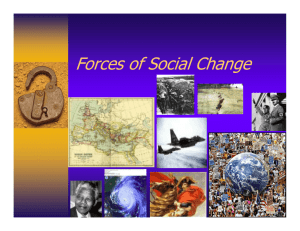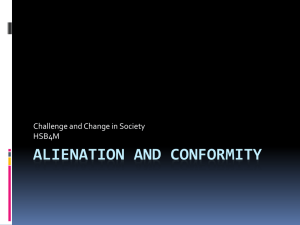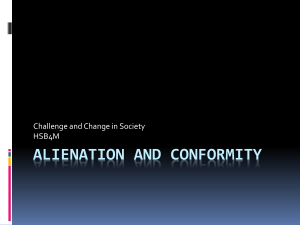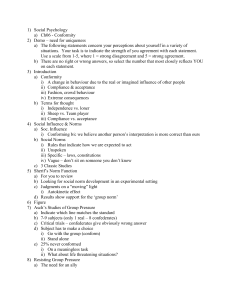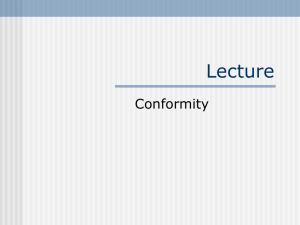File
advertisement
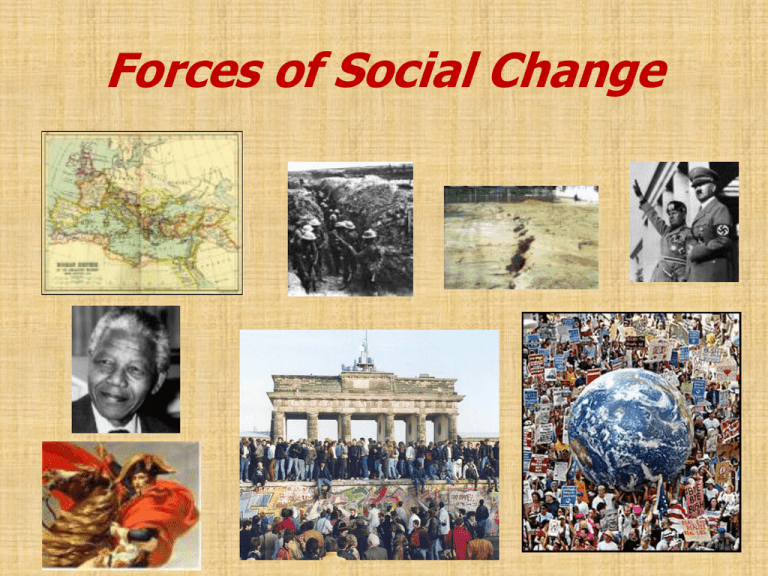
Forces of Social Change Group Activity • Working in groups of 3-4 , take out a piece of paper. – As a group, list the social changes that have taken place in your life, community, city, country and even globally. Think of changes in the past give, ten, fifty and one hundred years. TAKE IT UP! • One member from each group please come to the board and write out the list you and your group members came up with. • Article reading as a class- see handout- will be given in class. • www.cnbc.com/id/44504579/page/1 “Everyone over the age of forty is an immigrant” - Margaret Mead What does she mean by this? Do you agree? SO WHAT IS SOCIAL CHANGE? What is Social Change? • Social Change: Changes in the way society is organized, and the beliefs and practices of the people who believe in it • All societies are involved in a process of social change, however this change may be so subtle and slow that society is hardly aware of it • The opposite of social change is social continuity which means that there are structures within society which are built to resist change. Positive or Negative • Social change can be positive or negative, depending on your perspective – I.e. Government cutbacks that reduce social services and reduce taxes can be seen by some as positive and others as negative • In your view, what are some positive social changes and what are some negative ones? Examples of Social Change • Question 1 – How has the development of housing in Toronto, Milton….(any other areas) changed? • Question 2: How has public opinion shifted regarding social issues such as: • -Smoking -Domestic Violence -Divorce -Abortion -premarital sex - Equal rights for gay and lesbian coupes • Discuss in your groups Group Presentation • INCLUDE: • In groups- 4-5 • Research one of the social issues and present to the class – Social issue – History of this social issue in Canada – Have there been some changes regarding this social issue? – What are some examples of this social issue in our society? – How do you perceive this social issue? – Suggest some strategies to address this social issue. Worksheet • Individually complete the worksheet titled, “ Identifying Social Change” • You will get your answers from the photocopied reading from the text pages 70-75. Conditions Necessary for Social Change • Change within society is a natural process that must take place. • Social institutions in society (i.e. government) hold a fair degree of respect as long as they: (a) fulfill the needs of most people and (b) the institutions recognize they must change over time as conditions and popular opinions change. • Some conditions that would justify the Forces that Impact Social Change • • • • • • • • Charismatic leader that promises change Role of the elites (when there isn’t ONE leader to take charge, there can be a group of ‘modernizing elites’) A populace ready for change Technological advancements Environmental factors External events Society suffers a major catastrophe or triumph There is a clash of traditions and values Charismatic Leadership • Originally, the term ‘charismatic’ had an exclusively religious meaning • Christians used the term to describe a person who was inspired by the Holy Spirit and chosen by God to as a leader • Sociologist Max Weber broadened the meaning of this term • What is charismatic leadership? – A leader who is characterized by: large vision, magnetic style, strong popular support and has aspects of an extraordinary character Power of the Individual(s)? • Sociologist Max Weber claimed that one of the most important components of social change was a LEADER with CHARISMA (large vision, magnetic style, strong popular support and extraordinary character). This leader places great demands on his or her followers, promises rewards for their support . Examples? • Sociologist Samuel Eisenstadt claimed that in most societies, there exists one or more MODERNIZING ELITES, groups of people who create significant social change and influence the direction it goes Examples? A Populace Ready for Change • Charismatic leadership and a group of elites can redirect a society down a certain path • BUT if a population isn’t ready for the changes a leader or a group of elites propose, nothing will happen • For this relationship to work, the vision of the leader(s) have to match the mood of the public – otherwise no one will listen and the potential leader(s) will be quickly forgotten Natural Forces of Social Change GEOGRAPHY • This is when the natural lay of the land has affected the way societies have developed Examples? • Natural disasters can also drastically change a society (floods, earthquakes, volcanoes) ENVIRONMENT • Pollution, garbage, ozone, car emissions, smog, recycling • national, provincial and local programs that address environmental problems • Effects? External Events as Forces of Social Change • External events are events that have occurred on a large scale affecting an entire nation or several nations • These events have a large and immediate impact on social change Examples • American Civil War – abolished slavery • WWII – forced women into the workforce and they never returned home • September 11/2001 – a change of thought regarding national threat and security Poverty and Affluence • Karl Marx was first to point sociology to study inequality in society • Income inequalities: gap between earnings of the rich and poor • Is social inequality an inherent part of human social structures? • Does society have a responsibility in trying to deal with the effects of income inequality? • Effects? - education, crime, housing • Examples? Values and Social Change: • Singularity- belief that everyone in society should act and think the same way • Pluralism- widespread acceptance of differences in culture, religion, values and lifestyle • Inclusiveness- all law abiding people, regardless of their particular background, should be able to play a constructive role in the life of the nation • Examples: struggle for inclusiveness with women obtaining equal roles and status to traditionally ‘male’ roles Technology • Technology has strongly affected the way societies are designed and how they keep changing • People receive their information more quickly now, can communicate in different ways • Greatest invention of the millennium? Guesses? • Impact… Coping with Technological Change – Positive or Negative??? • • • • • • Over dependency Creation of ‘mass culture’ Changes in Gender roles Social Isolation Addiction Positive and Negative consequences? • Luddites: People who oppose new technologies are often called “luddites” after a secret society whose goal it was to destroy new textile machines during the early years of the Industrial Revolution Activity • In groups define; – Alienation – Conformity – How do these terms link to social change/challenges- discuss in your group Conformity • Behaviour in agreement with generally accepted standards and practices; pressures that encourage us to accept social norms • Social norms: A standard shared by members of a group, to which members are expected to conform. The most typical behaviour, attitudes or opinions found in a group. Conformity of the People • Conformity is the act of maintaining a certain degree of similarity (in clothing, manners, behaviors, etc.) to those in your general social circles, to those in authority, or to the general status quo. Usually, conformity implies a tendency to submit to others in thought and behavior other than simply clothing choice • Informational Influence: human desire to accept information that another, admired person tells us is valid (ie. Parent, teacher, coach) • Normative Influence: pressure to conform to the positive expectations of others (ie. Follow in footsteps of parent’s career) • Effects? Asch Line Experiment • https://www.youtube.com/watch?v=TYIh4Mk cfJA Everyday Conformity • Examples: – Lines at a fast-food restaurant – Bus stops as people wait for a bus – Students’ clothing. Are they all 'individuals, or do they conform to an implicit dress-code? – Are people conforming to posted rules, or do they conform to informal norms? • What ways have you changed your behaviour to fit in with a group? Conformity in Contemporary Society • Most people conform to the standard values and norms without even realizing they are doing so • Some degree of conformity is necessary for societies to function • i.e. Stopping at a red light means that you are conforming to the law and the good and safety of society Conformity and Youth • Pre-teens and teenagers face many issues related to conformity • Pulled between the desire to be seen as unique individuals and desire to belong to a group where they feel accepted • i.e. wearing the latest fashion, cutting your hair into a certain style, smoking, changing the type of music you listen to • All of these are examples of conforming to a social norm Experiencing Nonconformity • If you violate norms of civility, people will react. – On a crowded bus, hum loudly or sing out loud. – Try to barter for a small purchase at a fast food restaurant. – When someone says "Hi, how are you," ask them "Do you mean physically, mentally, or financially?" – Shopping from others’ carts in a grocery store. When questioned, respond simply that the item in the cart had been more convenient to reach than the one on the shelf. – Stand very, very close to a person while otherwise maintaining an inoffensive conversation Adapting to Change: Alienation • A feeling that one does not share in the major values and goals of society • Early sociologists (19th century) lived in a time of extensive change as society adapted to urban life and industrial processes • They observed a social condition among many in society who had difficulty adapting Durkheim and Marx • Sociologist Emile Durkheim (1859-1917) coined the term anomie to describe the conditions of industrial workers who had no roots or norms as they struggled to survive • Sociologist Karl Marx (1818-1883) took this term and applied it the proletariat (working people) and the bourgeoisie (unemployed people). – He claimed the workers were exploited and controlled (i.e. in their ability to find paid employment and housing) and could never reach their full human potential • Marx’s notion of alienation has been expanded to mean anyone who does not share the major values of society and feels like an outsider. Effects? • Conformity…GOOD? • Encourages social interaction • Creates predictable behaviour • Maintains social order Conformity…. BAD? • Discourages social change • Can lead people to resist the temptation to do things differently • Can encourage people to accept practices that are wrong • An unwillingness to conform could risk social rejection • An individual who is deliberately excluded from a social relationship or social interaction is a victim of social rejection. • Conformity acts as a scapegoat in order to avoid bullying and criticism from peers. • I.e. Milgram experiment • http://www.youtube.com/watch?v=C3adPFp Alienation…GOOD? • Spurs reformers into action • Leads individuals to struggle with the status quo • Leaders and movements in society are born Alienation…BAD? • Can be so severe that people give up and accept life in the margins of society • Can lead to suicide or substance abuse • See Merton Discussion Questions: Society • In today’s society – are there pressures to conform? In what ways? • What are the repercussions to not “conforming”? • How different would life be? Activity: Small Group Discussion • In small group list all the different ways you are pressured to conform in society • Do you Conform? What happens if you don’t? • How much of a role does family, friends and school play in the pressure in your life to conform? • Do you notice this pressure on a daily basis? • Does society need its citizens to conform to function effectively? Key Questions for Today • What groups in society may feel socially isolated? • Why is this? • What groups in society are forced to conform? Scenarios • Discuss the following questions with your group: • A) What are the triggers to conform in this scenario? • B) What feelings did the person in the situation feel to potentially make them change their behaviour? • C) What would you have done in this situation? Scenario 1 • You are waiting to cross the street and the light is red. A group of pedestrians start to cross the street before the green light even though there remains some risk of oncoming traffic. What do you do? Scenario 2 • You are looking for garbage at a concert. You find one but it is full and you see people just throwing garbage on the ground around the garbage can. What do you do? Scenario 3 • You have been standing in line for hours waiting to buy tickets for a concert / sports game. A group of 6 people try to ‘bud’ in line with a friend. The people waiting start yelling and objecting as there are only a specific amount of tickets. What do you do? Scenario 4 • A senior student approaches you and a bunch of your friends offering to sell you his / her old assignments and copy of tests for a class. All of your friends agree to this and are waiting for your decision. What do you do? Scenario 5 • You have just started a new job and are sitting around with your new coworkers. Someone tells a joke that is very racist and everyone is laughing and starts telling more racist jokes that you find offensive. What do you do? Scenario 6 • A bunch of you are at a friends for dinner—after dinner all your friends get up from the table and leave their plates as you are late for a party. You have been brought up to always clear your plate from the table and help clean up. What do you do? Discussion • Which situation would be the most easy and most difficult in terms of resisting conformity? • Why? Isolation • Known as a state of seclusion • i.e. a lack of contact with people • May stem from: – Bad relationships – Deliberate choice – Contagious disease – Repulsive personal habits – Mental illness Isolation in society • Feeling marginalized in society could force people to resist the social norm • Unrest in society could lead to isolation, not feeling included in society

